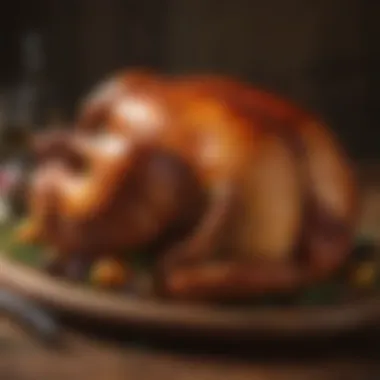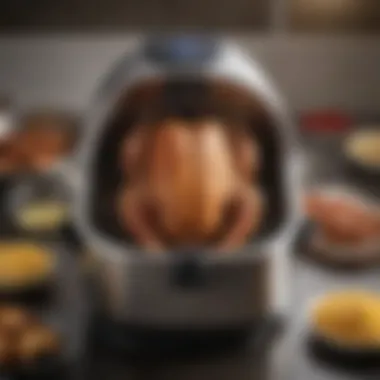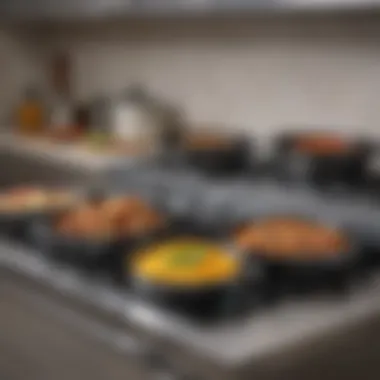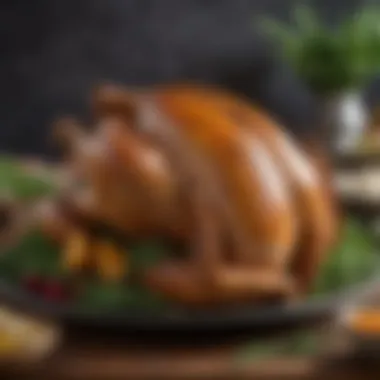Comprehensive Guide to Cookers for Turkey


Intro
Cooking a turkey is often the centerpiece of festive gatherings and special occasions. However, choosing the right cooker can dramatically influence the taste and texture of the final dish. With an array of options available, from conventional ovens to contemporary electric turkey fryers, understanding each method is crucial. This guide aims to provide a comprehensive overview, detailing the efficiency, techniques, and selection criteria tailored for turkey preparation.
Consider not only flavor but also safety and nutritional aspects when preparing turkey. Each method comes with its own set of advantages and disadvantages, which greatly affect the cooking experience and outcome. This exploration will help you navigate the options available, ensuring you select the best one for your needs.
If you are passionate about cooking or simply want to enhance your turkey preparation skills, the information provided here is invaluable. In the sections that follow, we will delve into various cookers, techniques, safety considerations, and trends that can elevate your turkey cooking to the next level.
Understanding Cookers for Turkey
Choosing the right cooker for turkey preparation plays a crucial role in achieving flavorful and moist results. Each cooking appliance has its unique mechanics and impact on the cooking process. An informed choice can contribute not only to the taste and texture of the turkey, but also to efficiency, time, and energy consumption. It is important to recognize that a turkey is often the centerpiece of festive feasts, and how it is cooked can influence the overall dining experience.
By understanding different cookers, home chefs can select the most suitable method that aligns with their culinary goals, skill level, and available resources. Factors like size, energy consumption, and usability directly affect the cooking outcome. Each cooking method showcases versatility, allowing for various flavors and textures, which makes it essential to delve into their specifics.
"A well-cooked turkey can elevate any meal, making the right cooker a vital tool in the kitchen."
In this guide, the various types of cookers are detailed to highlight their efficiency and techniques. This information will assist readers in making knowledgeable decisions while preparing turkey.
Importance of Choosing the Right Cooker
Selecting the right cooker can define the entire turkey preparation process. It influences not only how the turkey cooks but also the final flavor and texture. Different cookers provide unique advantages and disadvantages. For example, a conventional oven is ideal for traditional roasting, while an electric turkey fryer offers a crispy outside with less cooking time. Choosing a cooker also impacts kitchen space and cooking within a specific timeframe, especially during busy holiday seasons.
Beyond the logistics, the choice of cooker can also affect energy efficiency. Some cookers may consume more electricity than others, translating to higher utility bills. This is an often overlooked factor, yet a significant one for chefs who are conscious about costs. Opting for a more energy-efficient option can also contribute positively to the environment.
Overview of Turkey Cooking Methods
Turkey preparation can be achieved through various cooking methods, each adding distinctive qualities to the final dish. Here are several common techniques:
- Roasting: This method is perhaps the most traditional way to cook turkey. Usually done in a conventional or convection oven, roasting helps achieve a juicy interior with a golden and crispy exterior.
- Frying: Deep-frying turkey is a popular method that results in a moist and flavorful bird with a crunchy exterior. This method, however, requires careful temperature control and safety precautions.
- Brining: Though not a cooking method per se, brining is an essential procedure that enhances flavor and moisture retention during cooking. Brined turkey often yields a more tender and flavorful result.
- Grilling and Smoking: These methods impart unique flavor profiles and require different temperature settings and cooking times. Smoking, in particular, adds depth and complexity of flavor, making turkey an exciting choice for outdoor gatherings.
- Slow Cooking: Using slow cookers can help develop flavors over long cooking periods while maintaining moisture. This method is great for recipes that incorporate sauces and flavors over time.
Choosing the right cooking method, in conjunction with the appropriate cooker, can lead to a significantly improved turkey dish. With a thorough understanding of these methods, home cooks are better equipped to experiment and find the perfect combination for their taste preferences.
Types of Cookers Suitable for Turkey
Selecting the right type of cooker for turkey is crucial not just for convenience, but also for enhancing flavor, texture, and overall cooking efficiency. The diverse array of cooking appliances allows cooks to tailor the method to their preferences and needs. This section provides an in-depth look at various cooker types that are most suitable for preparing turkey, covering both the advantages and limitations each may present.
Conventional Ovens
Advantages
Conventional ovens have been a staple in home kitchens for decades. One main advantage is their ability to provide consistent and even heating. This characteristic is vital when cooking turkey, as it ensures that the meat is cooked thoroughly without drying out. Everybody enjoys that golden-brown exterior and juicy interior, and using a conventional oven can help achieve this. Additionally, these ovens usually have a large capacity, accommodating even the largest turkeys, which is beneficial during holidays or large gatherings.
Limitations
Despite their advantages, conventional ovens have some limitations. They may take longer to preheat compared to other options, which can be inefficient when time is tight. Another aspect is that they may require regular monitoring to ensure that the turkey cooks evenly. If poorly timed, the turkey can end up with overcooked parts or unevenly browned skin.
Convection Ovens
Heat Distribution Mechanism
Convection ovens are unique due to their built-in fans that circulate hot air around the food. This mechanism promotes even heat distribution, which can be particularly beneficial for cooking turkey. It helps in reducing cooking times, allowing for a more efficient cooking process. The design not only leads to better heat exposure but can also result in a pleasantly crispy skin on the turkey.
Impact on Cooking Time
The impact on cooking time with convection ovens is quite significant. Generally, they can cook food up to 25% faster than conventional ovens. This can be a major time-saver during busy cooking sessions. However, cooks must adjust recipes accordingly, as traditional cooking times may not apply directly with this method.
Electric Turkey Fryers
Benefits of Frying
Electric turkey fryers offer a unique approach to cooking turkey by submerging the bird in hot oil. This method results in a remarkably crispy texture and rich flavor. One major benefit is the speed of cooking. Fried turkey can take as little as 45 minutes, making it a quick alternative for those short on time. This efficiency can be appealing for both casual cooks and seasoned chefs.
Safety Considerations


However, safety is paramount when using electric fryers. There are risks of oil spillage and burns. Users must ensure proper setup and follow safety guidelines carefully. Keeping the fryer on a stable surface and away from flammable materials is crucial. Education on the equipment's use can mitigate these dangers effectively.
Grills and Smokers
Flavor Profiles
Utilizing grills and smokers adds distinctive flavors to turkey that are hard to replicate with other cooking methods. The addition of wood chips for smoking gives the meat a rich, smoky flavor that many find appealing. The open flame from grilling also imparts a unique char that contributes to the overall taste profile.
Temperature Control
Temperature control is critical when using grills and smokers. Proper management of heat is necessary to avoid undercooking or overcooking the turkey. Unlike traditional ovens, achieving the perfect temperature can be more challenging. It requires experience and attentiveness, but the flavor rewards can be well worth the effort.
Slow Cookers
Preparing for Longer Cooking Times
Slow cookers present a fantastic option for those who desire hands-off cooking. Preparing turkey in a slow cooker generally takes several hours, but the end result is often tender meat that is full of flavor. This method allows flavors to meld beautifully as the turkey slow cooks, giving a satisfying output.
Moisture Retention
Another significant advantage of slow-cooking is moisture retention. The covered design keeps steam and moisture locked in, which prevents the turkey from drying out. When done correctly, the turkey emerges succulent and flavorful, showcasing why many choose this method for comfort food gatherings.
Pressure Cookers
Quick Cooking Benefits
Pressure cookers significantly reduce the cooking time for turkey, making them highly efficient. By sealing in moisture and building steam, they can cook a turkey faster than almost any other method. This efficiency makes pressure cookers appealing for those with tight schedules.
Common Pitfalls
Despite their efficiency, pressure cookers do have common pitfalls. It can be easy to overcook the turkey if not monitored properly. Additionally, there is a learning curve involved in understanding how to operate a pressure cooker effectively. While they can produce great results, attention to detail is essential.
Key Factors in Selecting a Cooker
Selecting the right cooker for turkey requires careful consideration of several key factors. Understanding how to evaluate these elements can lead to a more successful cooking experience. Each homeowner or chef can make informed decisions based on personal needs and cooking habits. The following sections delve into critical factors: size, energy efficiency, and ease of use.
Size Considerations
Turkey Size Guidelines
In preparing turkey, size matters. Knowing the right size of the cooker is crucial. The general rule is to allocate one pound of turkey per person, but it is also important to consider the cooker's internal space. Different cookers accommodate varied sizes of turkey, from small 8-pounders to large 25-pound giants.
A notable characteristic of having proper size guidelines is that it allows for even cooking. When the turkey fits well in the cooker, heat distributes more uniformly. This uniformity leads to better flavor and texture. Conversely, a cooker too small can result in overcooking or undercooking, affecting the outcome of the meal. Thus, accurate size guidelines are essential for achieving the desired results.
Space and Storage
Where will the cooker live when not in use? Space and storage are significant aspects to consider. The dimensions of the cooker must fit not only in the kitchen but also in any storage area after cooking. Larger cookers may require additional space.
A beneficial characteristic of assessing space and storage needs is the practicality it offers when making a choice. Compact models are excellent for smaller kitchens but may limit cooking capacity. Generally, suitable storage options prevent clutter and enhance kitchen organization. Small kitchens benefit from versatile designs that can be stored easily without occupying much space. Therefore, understanding space and storage plays a vital role in cooker selection.
Energy Efficiency
Cost of Operation
The cost of operation is a vital consideration. Over time, the energy consumed to cook turkey can add significantly to household expenses. Each type of cooker consumes a different amount of electricity or gas. For example, electric cookers usually consume less energy than conventional gas cookers.
Understanding this can influence choices favorably. Choosing an energy-efficient model can reduce the overall cost while maintaining performance. Moreover, some cookers emit less heat, which can keep kitchens cooler during the cooking process. Thus, evaluating the cost of operation leads to improved long-term savings and comfort.
Environmental Impact
The environmental impact of energy consumption has become an increasing topic of concern. Opting for more energy-efficient cookers contributes positively. Cookers that utilize less energy may produce fewer emissions, aligning better with the eco-conscious consumer's goals.
Many modern cookers are designed with energy-saving features. This not only supports cooking efficiency but also promotes sustainability. Each bit of reduction in energy usage matters. Therefore, considering the environmental impact aligns practical kitchen choices with broader ecological goals.


Ease of Use and Cleaning
User-Friendliness
User-friendliness can greatly enhance the cooking experience. The ideal cooker should have simple controls and an intuitive design. Some models come with presets that simplify cooking times and temperatures. Such functionalities aid even novice cooks, making preparation straightforward.
A characteristic of user-friendly designs is their accessibility. For specialized functions, many cookers offer digital interfaces that guide users step by step. This feature can save time during meal preparations and add convenience, directly impacting cooking success.
Maintenance Tips
Maintenance is often overlooked but is equally important. Keeping cookers clean ensures durability and optimal function. Many modern cookers have non-stick properties that make cleaning easier. Additionally, regular maintenance reduces the risk of malfunctions, extending the lifespan of the appliance.
A key maintenance tip is to clean the cooker after each use. Easy-to-remove parts can make this task less daunting. Being proactive about maintenance not only keeps the cooker performing efficiently but also ensures hygiene. Taking time for maintenance enhances reliability and sustains cooking performance.
Key Consideration: The right cooker not only needs to fit the turkey but also align with user comfort, economic efficiency, and ease of maintenance. These factors collectively create an environment suited for delicious turkey cooking.
Preparing Turkey for Cooking
Preparing turkey for cooking is a critical step that can significantly impact the final dish's flavor and texture. It involves a series of careful actions to ensure the turkey is not only safe to eat but also well-seasoned and tender. Proper preparation can elevate the cooking process, allowing for optimal taste and enjoyment.
Thawing Safely
Thawing is the first essential process when preparing turkey. It is important to do this safely to avoid foodborne illnesses. The safest method involves thawing in the refrigerator, where the turkey can gradually defrost at a controlled temperature. For every four pounds of turkey, plan on about 24 hours of thawing time. This method keeps the meat in a safe temperature range, minimizing the risk of bacteria growth.
An alternative method is cold water thawing. For this, the turkey must be sealed in a leak-proof plastic bag and submerged in cold water, changing the water every 30 minutes. This method is faster but requires more attention to ensure safety.
Important: Never thaw turkey at room temperature as it creates a breeding ground for bacteria.
Brining Techniques
Brining involves soaking the turkey in a saltwater solution, which can significantly enhance juiciness and flavor. It is a valuable technique used by many cooks to improve the overall outcome of a turkey dish.
Types of Brines
There are generally two main types of brines: wet brines and dry brines.
- Wet Brines: Involves dissolving salt in water and adding other flavor components such as herbs and spices. The turkey absorbs this solution, which enhances moisture content.
- Dry Brines: Uses salt alone or mixed with spices, rubbed onto the skin and meat. The turkey is then left in the refrigerator for several hours, allowing the salt to penetrate and season the meat.
Wet brines are popular for their ability to add moisture, while dry brines are less messy and keep the skin crisp.
Effects on Flavor and Texture
Brining affects the flavor by infusing the turkey with various seasonings, enhancing its natural taste.
- Flavor: A well-seasoned brine can add depth to the dish, as the spices dissolve in the meat fibers.
- Texture: The process of soaking the turkey can also change the texture by breaking down some proteins, making it more tender.
However, one must be cautious with the amount of salt used; too much can lead to an overly salty turkey, overshadowing its natural flavors. Understanding the right balance is crucial to achieve the desired outcome.
Common Cooking Mistakes
Understanding common cooking mistakes when preparing turkey is crucial for achieving a successful and delicious result. These follies not only affect the flavor but can also lead to food safety concerns. By recognizing and avoiding these errors, cooks can enhance their culinary skills and ensure that every turkey meal is a memorable one. This section will explore two critical mistakes that often occur during turkey cooking—overcooking and ignoring temperature guidelines.
Overcooking Turkey
Overcooking turkey is a prevalent issue that many face, often resulting in dry and tough meat. This situation happens when the bird is subjected to excessively high heat or prolonged cooking times. The texture of overcooked turkey can significantly detract from the dining experience, making it less enjoyable. To avoid this, it is essential to monitor cooking times closely while utilizing a food thermometer to check the inner temperature. The ideal internal temperature for cooked turkey should reach 165°F (74°C).
Moreover, resting the turkey after cooking helps in retaining moisture. When turkey is allowed to sit for about 20-30 minutes, the juices redistribute, leading to a more succulent eating experience. Here are some tips that can help prevent overcooking:
- Use a reliable meat thermometer. Accurate readings can save the turkey from drying out.
- Follow recommended cooking times based on the size of the bird. A general guideline is 13 minutes per pound at 350°F (175°C), but this may vary depending on the cooking method.
- Avoid opening the oven frequently; each time the door opens, it releases heat, leading to fluctuations in cooking time.
Ignoring Temperature Guidelines
Ignoring temperature guidelines poses significant risks both in terms of quality and food safety. Cooking a turkey to the correct internal temperature is essential in eliminating harmful bacteria such as Salmonella. Failure to reach these guidelines not only threatens the well-being of the diners but can also spoil the meal.


It is imperative to understand that different parts of the turkey may cook at varying rates. For instance, the thigh generally requires a longer cooking time compared to the breast. The turkey should not only reach 165°F (74°C) overall, but a good practice is to check the thigh and breast separately to ensure both have reached safe temperatures.
Here are key points to consider:
- Monitor the temperature in multiple spots of the turkey to guarantee even cooking.
- Allow for carryover cooking; the turkey continues to cook slightly after being removed from the heat source. Thus, aiming for 160°F (71°C) allows for this natural temperature rise to occur safely without risking overdoneness.
"The careful application of temperature guidelines is fundamental for producing both a safe and flavorful turkey."
In summary, taking note of cooking mistakes, especially involving overcooking and temperature guidelines, can lead to significant improvements in the turkey cooking process. By being diligent in following best practices, cooks can ensure a thoroughly enjoyable meal that not only tastes good but is safe for consumption.
Popular Turkey Recipes and Trends
The exploration of turkey recipes and trends is essential in this article because it connects cooking techniques to practical applications. Focusing on the preparation of turkey not only enhances culinary skills but also allows for creativity in flavor and presentation. As culinary trends evolve, understanding which recipes resonate with home cooks provides insights into cultural influences and individual preferences. Incorporating popular recipes ensures that cooks can appeal to a wide audience while maintaining traditional practices.
Classic Roasted Turkey
Classic roasted turkey stands as a symbol of festive gatherings. This recipe focuses on the traditional method of preparing turkey in an oven, ensuring a golden-brown exterior while retaining moisture inside.
To achieve a perfect roast, it is important to start with a properly thawed turkey and season it well. Combining salt, herbs, and butter under the skin can enhance the flavor significantly. A common cooking time guideline is to roast for about 13 minutes per pound at 350°F.
Here are key steps for roasting:
- Preheat the oven and prepare the roasting pan.
- Season turkey inside and out.
- Roast covered to retain heat, uncovering for the last hour.
- Use a meat thermometer to check an internal temperature of 165°F.
This preparation is straightforward yet rewarding. The resulting meal is often the centerpiece of holiday feasts, inviting guests to partake in a timeless tradition.
Innovative Marinades
In contrast to conventional approaches, innovative marinades introduce new flavors and moisture into the turkey. By using diverse ingredients such as fruits, spices, and acids, home cooks can create a distinctive taste profile. Marinades can break down protein fibers, leading to a more tender turkey.
Some popular marinade components include:
- Citrus juices for brightness
- Soy sauce for umami depth
- Honey for sweetness
- Herbs such as thyme or rosemary for aromatics
Marinating time can range from a few hours to overnight, depending on the intensity desired. This method allows for versatility and can cater to various flavor preferences, appealing to a modern, adventurous palate.
Regional Variations
Regional variations of turkey dishes emerge from local ingredients and cultural practices, creating unique flavors and preparation styles.
Cultural Influences
Cultural influences shape how turkey is cooked and seasoned across different regions. This diversity reflects local traditions and history. For example, in Southern cooking, turkey may be deep-fried with a spicy coating, whereas in the Northeast, a sage-infused stuffing is common. Each cultural approach introduces unique methods and flavors, enriching the overall culinary landscape.
The key characteristic of these cultural variations is their emphasis on local, fresh ingredients, making them both a popular choice and a way to connect with heritage. The inclusion of varied spices and cooking styles can lead to a wider appreciation of turkey as an ingredient.
Unique Ingredients
Unique ingredients play a vital role in crafting diverse turkey recipes. They can range from exotic spices to locally-sourced produce, emphasizing sustainability while delivering distinct flavors. For instance, the use of chipotle peppers can add a flavorful heat that diversifies the dish.
The key characteristic of using unique ingredients is their ability to transform a standard turkey recipe into something remarkable and personal. They allow cooks to express their culinary identity and creativity, bridging traditional methods with modern tastes.
Certain unique ingredients may present challenges, such as availability or preparation techniques. However, the advantages of incorporating these elements often outweigh the drawbacks, especially in enhancing the flavor profiles and fostering creativity in cooking.
Finale
In the realm of preparing turkey, the choice of cooker stands as a critical determinant of the final outcome. The insights discussed throughout this article reinforce the importance of understanding various cookers, their efficiency, and their respective techniques. With an array of options available, from conventional ovens to electric turkey fryers, each presents unique benefits and considerations that can significantly enhance the cooking experience.
Selecting the right cooker influences not only the flavor and texture of the turkey but also impacts the overall cooking process, including time management and energy consumption. Moreover, understanding these factors can lead to more informed decisions, ensuring that the turkey is cooked to perfection and tailored to suit personal preferences and dietary needs.
A few essential elements to keep in mind include:
- Cooking Method: Different cookers impart distinct flavors and textures, impacting your final dish.
- Safety Considerations: Operating different types of cookers entails varied safety protocols, which should be a priority.
- Efficiency: Your choice may also affect energy usage and costs, contributing to an eco-friendly cooking approach.
Ultimately, knowledge is the first step toward mastering turkey preparation, making it essential for food lovers at all levels. By applying this knowledge, cooks can elevate their culinary ventures, making each turkey meal a memorable one.
Final Thoughts on Turkey Cooking
When it comes to turkey cooking, every detail counts. Paying attention to the selection of your cooker, preparation methods, and cooking techniques plays a crucial role in the overall success of the meal. Familiarity with the various options, like slow cookers or pressure cookers, allows for better control over outcomes.
Cooking turkey can seem daunting due to its size and the expectations surrounding it. However, with ample preparation, including safe thawing and effective brining methods, the process becomes manageable. Recipes that highlight regional variations and innovative marinades further encourage culinary creativity. This exploration not only elevates the dining experience but also fosters a deepened appreciation for this holiday staple.







